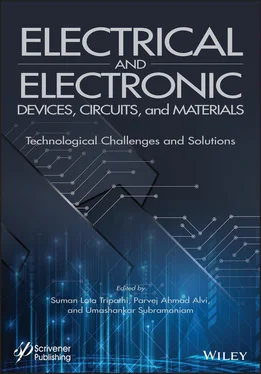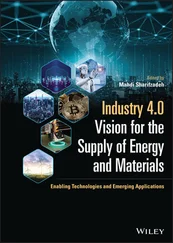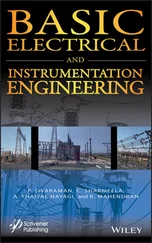18. Martin J. S., Bournel A., Monsef F., Chassat C., & Dollfus P. (2006) Multi sub-band Monte Carlo simulation of ultrathin double gate MOSFET with 2-D electron gas. Semicond. Sci. Technol. 21. 29–31.
19. Michielis M. D., Esseni D., Tsang Y. L., Palestri P., Selmi L., O’Neill A. G., & Chattopadhyay S. (2007) A Semianalytical Description of the Hole Band Structure in Inversion Layers for the Physically Based Modeling of pMOS Transistors. IEEE Trans. Electron Devices . 54. 2164-73.
20. Batwani H., Gaur M., & Jagadesh Kumar M. (2009) Analytical drain current model for nanoscale strained-Si/SiGe MOSFETs. COMPEL - International Journal for Computation and Mathematics in Electrical and Electronic Engineering . 28(2). 353-371.
21. Chatterjee S., Sikdar S., Chowdhury B. N., & Chattopadhyay S. (2019) Investigation of the performance of strain-engineered silicon nanowire field effect transistors (ε-Si-NWFET) on IOS substrates. Journal of Applied Physics . 125(8). 082506.
22. Sinha K, Rahaman H, & Chattopadhyay S. (2012). A Study on the Performance of Stress Induced p-channel MOSFETs with Embedded Si 1-xGe xSource/Drain. 5th International Conference on Computers and Devices for Communication (CODEC-2012). India. 1–4.
23. Thompson S. E, Sun G., Choi Y. S., & Nishida T. (2006). Uniaxial-Process-Induced Strained-Si: Extending the CMOS Roadmap. IEEE Transactions on Electron Devices. 53(5). 1010–1020.
24. Xu N., Ho B., Choi M., Moroz V., & Liu T-J. K. (2012). Effectiveness of Stressors in Aggressively Scaled FinFETs. IEEE Transactions on Electron Devices . 59(6). 1592–1598.
25. Yu T-H, Ho J-H, Liu C-W, Wang C-C. Chen W-Y, Chen H-S, Wu K-H, Tu K-C, Hsieh W-H, Huang C-F, Shen T-M, Sheu Y-M, Wu J, & Diaz C.H. (2012) Improvement of Drive Current Prediction in FinFET using Full 3D Process/Stress/Device Simulations. International Conference on Simulation of Semiconductor Processes and Devices, (SISPAD ‘12). USA .
26. Gupta S., Moroz V., Smith L., Lu Q., & Saraswat, K.C. (2014) 7-nm FinFET CMOS Design Enabled by Stress Engineering Using Si, Ge, and Sn,. IEEE Transactions on Electron Devices. 61(5). 1222–1230.
27. Sinha K, Chattopadhyay S, Gupta P. S., & Rahaman H. (2017) A technique to incorporate both tensile and compressive channel stress in Ge FinFET architecture. Journal of Computational Electronics . 16(3). 620–630.
28. Sinha K, Gupta P. S., Rahaman H, & Chattopadhyay S. (2018) Incorporation of Tensile and Compressive channel Stress by Modulating SiGe Stressor length in Embedded Source/Drain Si-FinFET Architecture. IEEE Electron Device Kolkata Conference (EDKCON). India. 126–131.
29. Maity C. K., Chattopadhyay S., Bera L.K. (2007) Strained-Si Heterostructure Field Effect Devices . The Taylor & Francis Group. UK.
30. Sinha K, Gupta P. S., Chattopadhyay S, & Rahaman H, (2016) Investigating the performance of SiGe embedded dual source p-FinFET architecture. Superlattices and Microstructures . 98. 37–45.
31. Harmand J. C., Matsuno T., & Inoue K. (1989). Lattice-Mismatched Growth and Transport Properties of InAlAs/InGaAs Heterostructures on GaAs Substrates. Japanese Journal of Applied Physics . 28(2). Number 7. L1101.
32. Hamada A., Furusawa T., Saito N., & Takeda E., (1991) A new aspect of mechanical stress effects in scaled MOS devices. IEEE Transactions on Electron Devices . 38(4). 895-900.
33. Ito S., Namba H., Yamaguchi K., Hirata T., Ando K., Koyama S., Kuroki S., Ikezawa N., Suzuki T., Saitoh T., & Horiuchi T. (2000) Mechanical stress effect of etch-stop nitride and its impact on deep submicron transistor design. International Electron Devices Meeting IEEE . 247–250.
34. Gannavaram S., Pesovic N., & Ozturk C. (2000) Low temperature (800°c) recessed junction selective silicon–germanium source/drain technology for sub-70 nm CMOS. IEEE Int. Electron Devices Meeting Tech. Digest . 437–440.
35. Fossum J. G., & Zhang W. (2003) Performance projections of scaled CMOS devices and circuits with strained Si-on-SiGe channels. IEEE Trans Electron Devices . 50(4). 1042–1049.
36. Thompson S. E., Suthram S., Sun Y., Sun G., Parthasarathy S., Chu M., & Nishida, T. (2006). Future of Strained Si/Semiconductors in Nanoscale MOSFETs. International Electron Devices Meeting, San Francisco, CA , 1-4.
37. Arghavani R., Derhacobian N., Banthia V., Balseanu M., Ingle N., M’Saad H., Venkataraman S., Yieh E., Yuan Z., Xia L.-Q., Krivokapic Z., Aghoram U., MacWilliams K., & Thompson S. E. (2007). Strain Engineering to Improve Data Retention Time in Nonvolatile Memory. IEEE Trans Electron Devices , 54(2). 363–365.
38. Xuan Y., Shen T., Xu M., Wu Y. Q., & Ye P. D. (2008) High-performance surface channel In-rich In 0.75Ga 0.25As MOSFETs with ALD high-k as gate dielectric. IEEE International Electron Devices Meeting, San Francisco .
39. Yokoyama M., Yasuda T., Takagi H., Yamada H., Fukuhara N., Hata M., Sugiyama M., Nakano Y. Takenaka M., & Takagi S. (2009) High mobility metal S/D III-V-On-Insulator MOSFETs on a Si substrate using direct wafer bonding. Symposium on VLSI Technology , 242–243.
40. Drummond T. J., Zipperian T. E., Fritz I. J., Schirber J. E., & Plut, T. A. (1986) p-channel strained quantum well field-effect transistor. Appl. Phys. Lett. 49, 461.
41. Grivickas, P., McCluskey M. D., & Gupta Y. M. (2009) Transformation of GaAs into an indirect L-band-gap semiconductor under uniaxial strain. Phys. Rev. B , 80, 073201.
42. Montazeri M., Fickenscher M, Smith L. M., Jackson H. E., Yarrison-Rice J., Kang J. H., Gao Q., Tan H. H., Jagadish C., Guo Y., Zou J., Pistol M–E., & Pryor C. E.. (2010) Direct Measure of Strain and Electronic Structure in GaAs/GaP Core−Shell Nanowires. Nano Letters 10 (3), 880-886.
43. Elisa G., Aline F., Thomas L., & Daniele P. (2019).Real-time monitoring of stress evolution during thin film growth by in situ substrate curvature measurement. Journal of Applied Physics . 125(8), 082513.
44. Li S., Chou J–P., Zhang H, Lu Y., & Hu A. (2019). A study of strain-induced indirect-direct bandgap transition for silicon nanowire applications. Journal of Applied Physics , 125(8), 082520.
Email : kunalsinha84@yahoo.co.in
2
Design and Optimization of Heterostructure Double Gate Tunneling Field Effect Transistor for Ultra Low Power Circuit and System
Guenifi Naima1* and Shiromani Balmukund Rahi2
1LEA Electronics Department, University Mostefa Benboulaid of Batna 2, Batna, Algeria
2Department of Electrical Engineering, Indian Institute of Technology Kanpur, India
Abstract
Tunnel FET, a quantum device nowadays known as the best suitable candidate for the future of ultra-low-power applications, due to a distinct current transport mechanism, known as band-to-band ( B2B ) tunneling. This device is recommended as a replacement for conventional Metal-Oxide-Semiconductor ( MOS) FET due to limitation of subthreshold slope (i.e., SS < 60 mV/ dec at T = 300 K), a bottleneck issue for modern low-power design and process engineers. In this chapter, we have mainly focused on double gate ( DG ) TFET , having band engineering and high - k dielectrics. Due to successful implementation of both these scientific suggestions, the DG -TFET shows improved device characteristics in terms of current efficiency ( ION ), leakage current ( IOFF ), subthreshold slope ( SS ), ambipolar current ( Iamb ), transconductance ( gm ), transconductance efficiency ( gm/IDS ), switching response time (ι d ), and power delay product ( PDP ). In this chapter, the transfer ( Id -Vg ), C - V and RF characteristics DG -TFET are investigated in detail.
Читать дальше












